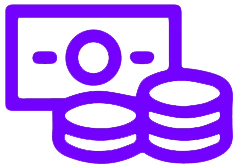Types of Contact Center Metrics
Contact center metrics can be broadly categorized into three main areas: customer satisfaction, agent productivity, and operational efficiency. Understanding how many customers request callbacks and tracking customer churn rate are crucial for enhancing staffing efficiency and improving customer satisfaction by addressing unresolved issues. Each category focuses on different elements of the call center’s performance. For instance, customer satisfaction metrics like CSAT and NPS provide insights into how customers perceive their interactions with the center, while agent productivity metrics such as Average Handle Time (AHT) and First Contact Resolution (FCR) measure the efficiency and effectiveness of the agents. Additionally, center performance metrics play a crucial role in assessing overall operational success.
Operational efficiency metrics are equally important as they help in managing resources and ensuring smooth workflows. Metrics such as call arrival rate and average after-call work time (ACWT) are crucial for understanding and optimizing the workload and performance of agents.
By tracking these different metrics, call center managers can gain a comprehensive view of their operations, identify strengths and weaknesses, and implement strategies to improve overall performance.
Key Customer Experience Metrics
Customer experience is the cornerstone of any successful contact center. To ensure that customers are satisfied and loyal, it is essential to monitor specific metrics that reflect the quality of service provided. These key performance indicators (KPIs) include the Customer Satisfaction Score (CSAT), Net Promoter Score (NPS), and Customer Effort Score (CES). Monitoring these metrics helps call center managers understand how well their teams are performing and where improvements are needed.
High customer satisfaction scores indicate a lower likelihood of customer attrition, making CSAT a critical metric for maintaining a loyal customer base. Similarly, NPS measures customer loyalty and the likelihood of customers recommending the service to others, while CES assesses the effort required by customers to resolve their issues. Each of these metrics provides unique insights into the customer experience and helps identify areas for improvement.
By focusing on these metrics, contact centers can ensure they meet and exceed customer expectations. For instance, a high First Contact Resolution (FCR) rate not only indicates efficient issue resolution but also leads to higher customer satisfaction and loyalty. Let’s take a closer look at each of these key customer experience metrics.
Customer Satisfaction Score (CSAT)
Customer Satisfaction Score (CSAT) is a direct measure of how satisfied customers are with the support they receive. Typically, it is measured through surveys where customers rate their satisfaction on a scale, often from “very unsatisfied” to “very satisfied.” The CSAT score is then calculated by dividing the number of satisfied customers by the total number of survey responses, providing a clear indication of customer happiness with the service.
A remarkable 95% of contact center professionals consider CSAT to be the key metric for assessing customer satisfaction. This highlights the critical role CSAT plays in their evaluation processes. Tracking CSAT over time allows managers to identify performance trends and make necessary adjustments to improve customer happiness. Higher CSAT scores indicate that the contact center is delivering a better customer experience.
Encouraging customers to complete surveys and assuring anonymity can increase the number of responses, providing more comprehensive data for analysis.
Net Promoter Score (NPS)
The Net Promoter Score (NPS) measures customer loyalty by asking customers how likely they are to recommend the company to others on a scale from 0 to 10. The NPS is calculated by subtracting the percentage of detractors (those who scored 0-6) from the percentage of promoters (those who scored 9-10). A higher NPS indicates a larger proportion of loyal customers, which can lead to increased recommendations and customer retention.
This metric helps categorize customers into promoters, passives, and detractors, providing insights for strategic improvements.
Customer Effort Score (CES)
Customer Effort Score (CES) measures the ease with which customers can resolve their issues. It is typically determined through surveys asking customers to rate the level of effort required to resolve their issues on a scale. Higher CES scores indicate a smoother support experience, which correlates with better overall customer experiences and higher customer loyalty.
Lowering customer effort not only enhances satisfaction but also promotes customer retention and loyalty.
Agent performance metrics are crucial for measuring the efficiency and productivity of contact center agents. These metrics provide insights into how well agents are performing their tasks and where improvements are needed. Key performance indicators for agents include Average Handle Time (AHT), First Contact Resolution (FCR), and Agent Utilization Rate. By monitoring these metrics, call center managers can ensure that agents are meeting performance standards and delivering high-quality service.
Productivity metrics help track and measure efficiency, manage performance, and highlight areas for improvement. For instance, lower Cost Per Call (CPC) indicates better productivity and cost management. Regular assessment of contact quality ensures that customer interactions meet established standards for service excellence.
Let’s explore some of these essential agent performance metrics in more detail.
First Contact Resolution (FCR)
First Contact Resolution (FCR) is one of the most important KPIs in a call center, significantly improving customer experience. High FCR rates indicate that agents are effectively resolving customer issues during the initial call, leading to increased customer satisfaction. The formula for calculating FCR is: (Total Issues Resolved on First Contact / Total Number of First Contacts) x 100. This formula helps determine the effectiveness of resolving issues on the first contact.
Tracking FCR helps collect valuable feedback regarding a company’s performance, guiding continuous improvement. High FCR rates typically correlate with excellent call quality and improved customer interactions.
Achieving high FCR rates requires effective training for team members and implementing strategies like predictive routing and quality management. Contact centers should aim to achieve FCR rates above industry benchmarks for optimal results.
Average Handle Time (AHT)
Average Handle Time (AHT) measures the average time agents take to handle calls, including talk time, hold time, and after-call work. The formula to calculate AHT is: AHT = (Total Talk Time + Total Hold Time + Total After Call Work Time) / Total Calls Handled. This provides an average handle time for calls. A low AHT indicates efficiency, but it is crucial to balance this with the quality of service to avoid rushing customers.
High AHT may signal inefficiencies in processes or agent skills, while low AHT may indicate agents are closing calls prematurely without confirming issue resolution. Tracking AHT can motivate agents and optimize resource usage in the contact center.
Ongoing improvements in AHT enhance productivity and customer satisfaction, ensuring agents remain efficient without compromising service quality.
Agent Utilization Rate
The agent utilization rate gauges the percentage of an agent’s logged-in time spent actively handling customer interactions. It is calculated by dividing the total handled call time by the total logged-in time and multiplying by 100. High utilization rates indicate that agents are spending maximum time on revenue-generating activities and highlight opportunities for optimization.
Investing in refresher training and tools like CRM can help improve the agent utilization rate.
Operational Efficiency Metrics
Operational efficiency metrics are essential for identifying areas that require improvements and optimizations in a contact center. These metrics help in managing resources, allocating staff effectively, and ensuring smooth workflows. Key performance indicators in this category include call abandonment rate, average speed of answer (ASA), and cost per call (CPC). By tracking these metrics, call center managers can enhance operational efficiency and provide better service to customers.
Understanding call arrival rates helps in effective staffing and resource allocation, ensuring that enough agents are available to handle customer inquiries efficiently. Analyzing peak hour traffic helps in strategically allocating resources during times of high demand to maintain service efficiency.
Let’s delve into some of these critical operational efficiency metrics.
Call Abandonment Rate
Monitoring the call abandonment rate is essential for enhancing customer satisfaction. Reducing this rate also helps in optimizing call center performance. The abandonment rate measures the percentage of calls that disconnect before being answered. High abandonment rates often indicate customer dissatisfaction and can lead to lost business opportunities. This metric can be calculated using the formula: (Number of Calls Abandoned / Total Number of Calls) x 100.
Reducing abandon rates often involves optimizing IVR menus and increasing agent staffing during peak times. Additionally, it’s important to keep callers informed about any delays. Offering customers a callback option can also improve the call abandonment rate by providing an alternative to waiting on hold.
Additionally, call center software can assist with abandoned calls by automatically creating tickets for follow-up.
Average Speed of Answer (ASA)
Average Speed of Answer (ASA) is a metric that gauges how long it typically takes for a call to be responded to. This measurement specifically reflects the time taken for a live agent to answer the call. Maintaining a low ASA is crucial because it reflects the responsiveness of the call center and impacts customer satisfaction. ASA is calculated using the formula: Total Waiting Time on Hold / Total Number of Calls Answered.
Optimizing ASA may involve implementing skills-based routing and cross-training. Additionally, ensure adequate staffing during peak times. A high ASA may indicate issues such as lack of training, insufficient staffing, or inefficiencies in processes.
Monitoring ASA is essential for minimizing customer frustration due to long wait times and ensuring prompt service.
Cost Per Call (CPC)
Cost Per Call (CPC) measures the average cost to handle each phone call, encompassing staffing and technology expenses. CPC is determined by taking the total cost of call center operations. This figure is then divided by the total number of calls handled.
Tracking CPC provides insight into the cost-effectiveness of operations and helps call centers remain financially efficient while maintaining high service quality. An increase in call resolution can lead to a reduction in CPC, indicating improved efficiency.
Advanced Metrics for Strategic Insights
Advanced metrics provide strategic insights that are essential for better decision-making in contact centers. These metrics help organizations understand the effects of various initiatives such as product launches and marketing campaigns on call volumes. They also aid in forecasting staffing needs and adapting to shifting trends in contact center traffic. Key performance indicators in this category include peak hour traffic analysis, repeat call rate, and contact quality monitoring.
By tracking these advanced metrics, call centers can identify peak hours and allocate resources more effectively. Real-time management of active waiting calls demonstrates how well teams are handling call volumes in the moment.
Measuring total inbound calls and outbound calls handled informs resource allocation decisions, ensuring that contact centers operate efficiently and provide high-quality service.
Peak Hour Traffic Analysis
Peak hour traffic analysis is essential for ensuring adequate staffing during high call volumes. Peak hours refer to the periods when call volumes are at their highest in contact centers. Monitoring peak hour traffic helps in optimizing staffing, ensuring that enough agents are available to handle customer inquiries efficiently.
Allocating resources properly during peak hours enhances customer satisfaction and reduces wait times.
Repeat Call Rate
The repeat call rate measures the frequency of repeat calls for unresolved issues. A high frequency of repeat calls indicates that issues remain unresolved during the first contact, leading to customer frustration. Tracking repeat call rates helps companies determine and resolve recurring issues faced by customers.
Implementing more self-service options can help mitigate customer frustration related to repeat calls. The goal is to minimize the number of repeat calls effectively.
Contact Quality Monitoring
Contact quality monitoring assesses how well customers interact with agents. It measures the quality of these interactions. This process involves designing a call quality evaluation form and using defined call quality monitoring software to analyze agent calls effectively. Tracking contact quality metrics helps understand customer needs and agent performance, ensuring interactions meet established standards for excellence.
NiCE is a leader in providing solutions that enhance contact center performance. By focusing on workforce optimization and customer satisfaction, NiCE’s performance management tools help call centers improve their operations. NiCE’s integrated solutions streamline workflows, connect systems, and enhance responsiveness and overall service quality in contact centers.
NICE’s solutions offer tools for real-time analytics, AI-driven insights, and integrated operations. These tools provide immediate visibility into call center operations, facilitating prompt adjustments and informed decision-making. Let’s explore how these tools can enhance contact center performance.
Real-Time Analytics
NICE’s real-time analytics tools are critical for contact centers as they offer immediate insights that can drive better decision-making. These tools enable real-time data collection, allowing contact centers to react swiftly to emerging trends and issues.
With capabilities such as call transcription, monitoring, sales performance metrics, and robust reporting, NiCE’s analytics add-on provides comprehensive insights into contact center operations.
AI-Driven Insights
NiCE utilizes AI for actionable insights that enhance customer engagement and service quality. Employing generative AI, NiCE simplifies extracting actionable insights, making it easier for call centers to identify areas for improvement without extensive analytical expertise.
These AI-driven insights enable contact centers to better understand customer interactions and optimize their performance.
Integrated Solutions
NICE’s integrated solutions streamline operations, thereby improving overall performance. Effective call center technology is crucial for operations, with analytics capabilities playing a particularly important role. Quality assurance analysts can identify areas of opportunity for improvement, contributing to better customer experiences.
The integration of technology and quality assurance leads to enhanced customer satisfaction and operational efficiency.
Improving contact center metrics requires a strategic approach that includes setting realistic goals, continuous training and development, and leveraging technology. Monitoring call center metrics is the first step in identifying performance gaps and areas for improvement. By consistently measuring important metrics, call center managers can ensure continuous assessment and enhancement of performance.
Setting data-driven goals facilitates a culture of improvement within the call center. Leveraging metrics data is crucial for improving contact center performance, as it informs strategy decisions and helps track trends in Customer Effort Score (CES).
Let’s delve into some best practices for improving contact center metrics.
Setting Realistic Goals
Goals should not only challenge the team but also be achievable to maintain motivation. Tracking CSAT over time helps identify performance areas and potential improvements. Setting improvement goals for agents is one method to enhance quality assurance scores.
Reducing high transfer rates may involve improving the IVR system and providing additional training to agents.
Continuous Training and Development
Ongoing training should be customized based on performance metrics to effectively boost agent skills. Continuous training programs are essential for keeping contact center agents skilled and motivated. Customized training enhances agents’ abilities, leading to improved service quality and efficiency.
Investing in continuous training ultimately contributes to higher customer satisfaction levels.
Leveraging Technology
Advanced technology can streamline processes, allowing for better matching of customer needs with agent availability. Advanced technology in contact centers can significantly enhance performance and customer satisfaction.
Leveraging technology helps improve the overall customer experience, reduce customer effort, and enhance customer interactions.
Summary
In conclusion, tracking and analyzing contact center metrics is essential for improving customer satisfaction and operational efficiency. By understanding and utilizing key metrics such as CSAT, NPS, CES, FCR, AHT, and CPC, call center managers can identify areas for improvement and implement strategies to enhance performance. Advanced metrics like peak hour traffic analysis, repeat call rate, and contact quality monitoring provide strategic insights that drive better decision-making.
NICE’s solutions play a significant role in enhancing contact center performance through real-time analytics, AI-driven insights, and integrated operations. By adopting best practices such as setting realistic goals, continuous training, and leveraging technology, contact centers can achieve higher levels of customer satisfaction and operational efficiency. Ultimately, the goal is to provide exceptional service that meets and exceeds customer expectations, fostering loyalty and long-term success.




